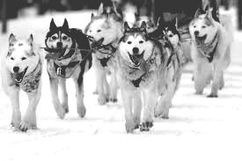
The Athlete’s Heart in Sled Dogs
by Peter D. Constable BVSc, MS, PhD, DipACVIM Assistant Professor, University of Illinois
The following is an excerpt taken from the above titled article which was published in the proceedings of the third annual International Sled Dog Veterinary Medical Association meeting (Edmonton, Alberta, 1996).
The occurrence of sudden death in sled dogs during racing, while rare, has considerable impact on public perceptions of the sport. It is important to relate this occurrence to that in human athletes performing similar exercise activities.
During cross country skiing, the sudden death rate for human athletes is 1/13,000 man hours. Let’s relate this to an Iditarod type race. Assuming an average team of 11 dogs for the duration of the race, a race completion time of 11 days and an average run time of 10 hours a day (all of these figures are ball park estimates), each team in the Iditarod has 1,210 dog hours of exercise activity. Assuming 60 teams are running in the race, this means that we have approximately 72,000 dog hours of exercise activity per race. Using the sudden death rate estimate from humans during cross country skiing, an estimate of 5.6 deaths per race is obtained. The fact that the actual number of sudden and unexpected deaths in the Iditarod is below this number suggests that dogs are better trained for mushing than humans are for cross country skiing.
During jogging, a much less strenuous and sustained activity for human athletes than is cross country skiing, the sudden death rate is 1/396,000 activity hours. This would translate to 0.2 death per Iditarod race.
by Peter D. Constable BVSc, MS, PhD, DipACVIM Assistant Professor, University of Illinois
The following is an excerpt taken from the above titled article which was published in the proceedings of the third annual International Sled Dog Veterinary Medical Association meeting (Edmonton, Alberta, 1996).
The occurrence of sudden death in sled dogs during racing, while rare, has considerable impact on public perceptions of the sport. It is important to relate this occurrence to that in human athletes performing similar exercise activities.
During cross country skiing, the sudden death rate for human athletes is 1/13,000 man hours. Let’s relate this to an Iditarod type race. Assuming an average team of 11 dogs for the duration of the race, a race completion time of 11 days and an average run time of 10 hours a day (all of these figures are ball park estimates), each team in the Iditarod has 1,210 dog hours of exercise activity. Assuming 60 teams are running in the race, this means that we have approximately 72,000 dog hours of exercise activity per race. Using the sudden death rate estimate from humans during cross country skiing, an estimate of 5.6 deaths per race is obtained. The fact that the actual number of sudden and unexpected deaths in the Iditarod is below this number suggests that dogs are better trained for mushing than humans are for cross country skiing.
During jogging, a much less strenuous and sustained activity for human athletes than is cross country skiing, the sudden death rate is 1/396,000 activity hours. This would translate to 0.2 death per Iditarod race.

